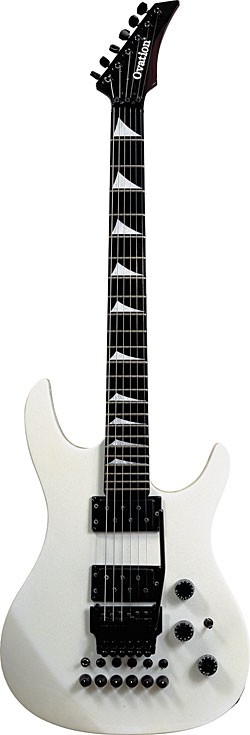
1986 Ovation GS2-R “Ripley”,
For a guitar detective, there’s nothing like a good mystery. What’s the story on this guitar? Where was it made? Who made it? If you’re lucky, you might even get to ask, “Who designed it?” and find an answer! Through the years, it’s been our pleasure to solve a lot of these mysteries, but here’s one that has us stumped. That is, we know a lot about this guitar, but getting to the “truth”… that’s another matter. For your consideration; a 1986 Ovation GS2-R guitar with Ripley electronics.
The Ovation part, at least at first, is pretty easy. We know Ovation was founded circa 1965 by Charlie Kaman, an engineer and guitar player who’d left Sikorski helicopters to form his own manufacturing company. As the story goes, he had his Martin guitars hanging on the wall in his Connecticut office so they’d be close when he felt like playing. The problem was that with season changes, the wood tended to expand and shrink, and at least one guitar developed a split. Kaman took it to Martin for repair. Looking around, he saw work with high tolerances and skilled craftsmen that echoed his own business. He offered to buy Martin, but the Martins were not interested. Kaman then made an offer to buy Kay, but that was rejected, as well. The more he thought about his own use of spruce and composite materials for helicopter blades, the more he thought it could apply to guitars. So he started a guitar company, and production commenced in 1966.
Kaman put his engineers to work developing a spruce and fiberglass (Lyracord) guitar and finally came up with an adequate solution. Kaman took an early model to Charlie Byrd, who loved the guitar and said it deserved an “ovation.” The name was born. Ovation acoustics made their way into the hands of Glen Campbell, who scored a network TV show in 1969 while playing one. It was Campbell who spurred the company to develop its piezo-electric pickups systems. The brand was on its way!
Ovation experimented with hollowbody electric guitars as early as 1968 with its Electric Storm series, with thinline bodies made in Germany, Ovation necks, and Schaller hardware. These were less than successful. Ovation moved on to solidbodies with the introduction of the battle-axe shaped Breadwinner in 1971, followed by its upmarket brother, the Deacon, in ’72. A number of Ovation electrics debuted in the ’70s, all meeting with limited acceptance and ending with Viper guitars and Magnum basses circa 1983.
Ovation didn’t give up on the idea of marketing solidbodies, however, and in ’85 introduced its Hard Bodies line, made in Korea and assembled in the U.S. These were not especially successful, either ,and lasted only about a year. In ’86, Ovation brought in 100 mystery guitars made in Japan… no details available (hold that thought). Other efforts followed, but Ovation finally solved its solidbody electric problem by purchasing the Hamer company in ’88. Finally, success!
Steve Ripley is also a known quantity – a talented guitar player with an interest in electronics who, in the early ’80s, came up with a novel system that featured stereo output and the ability to fade the pickup signal from each string to one channel or another (“fading” meaning to determine how much of a signal goes to each). The possibilities of such a system are truly psychedelic! The details remain to be discovered, but in ’84 Ripley hooked up with the rapidly growing Kramer guitar company, resulting in the heavily promoted Kramer RSG Ripley Stereo model, which was endorsed by Edward Van Halen. It’s not known how much, if any, influence Eddy may have had in the relationship. Kramer Ripleys came with one or two Bartolini-made pickups. It’s also unknown how many of these guitars were actually made, even though they were actively promoted for a couple years, they may well have been more prominent in advertising than in reality!
Which brings us to this Ovation GS2-R. According to Bill Kaman Jr., this guitar was part of an experiment in marketing the Ripley idea explored by Ovation in ’86. The guitar was made in Japan, the body is probably mahogany, and the bolt-on neck is pretty interesting, consisting of a multi-laminate maple neck with approximately 1/16″ reverse-grain strips glued together for strength (based on a concept by German guitar builder Framus). The neck is capped with a synthetic Ebonol fingerboard (ironically, an early Kramer innovation) with faux-pearl flag inlays. Each string can be turned on or off with a separate mini-toggle. There’s a fader pot for each string. Each pickup has its own volume and tone control. The vibrato system is licensed Floyd Rose and operates exactly like the Kramer. It plays and sounds great.
This “experiment” basically went nowhere. According to Bill Kaman, only about 20 to 30 were ever produced.
Which brings us to the crux of the mystery. Ripley doesn’t recall ever working with Kaman/Ovation. This is something most guitar designers would remember. Not the least of all from a check or two. Nada. The electronics on this guitar are either genuine Ripley or an exact copy. The GS2-R model designation suggests “guitar solid two-pickup Ripley.” Presumably, there may have been a one-pickup version.
There is any number of explanations for this memory discrepancy – disingenuousness is not one of them. Ovation clearly thought it was using Ripley’s ideas. Further speculation would be just that…
So, we come back to the reality that the Ovation GS2-R exists. Look at the picture! We know who made it (well, someone in Japan), when, and more or less why. We know who designed the electronics… But did he? It’s a fascinating conundrum, what you might call an “axe whodunit!”
This article originally appeared in VG‘s August 2008 issue. All copyrights are by the author and Vintage Guitar magazine. Unauthorized replication or use is strictly prohibited.



